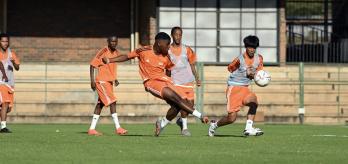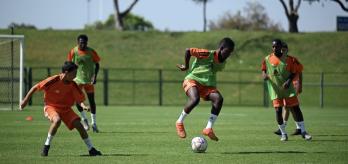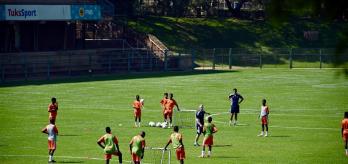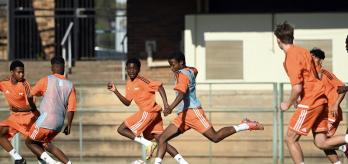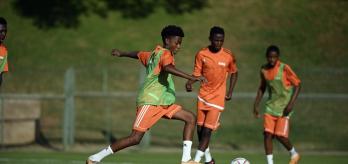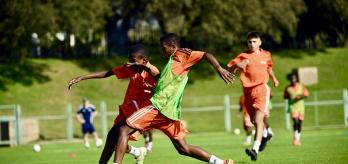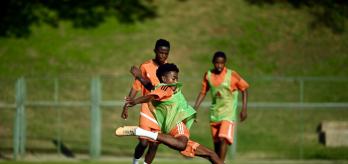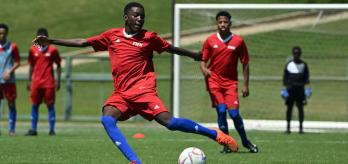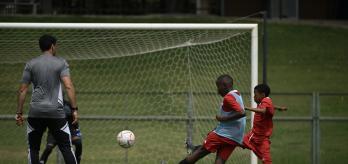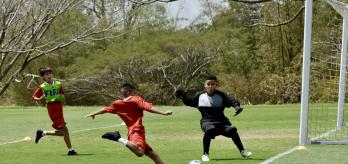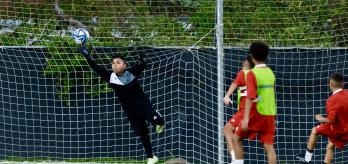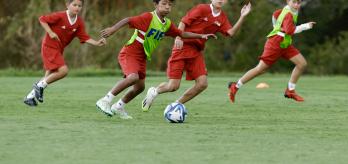Methodology
The intention: The practice type: What is practised?
The objective of the exercise is to enhance a team’s ability to create from the middle third and finish on goal within a broad focus. There are defensive aspects, such as denying and protecting, blocking and preventing and the transition to defend, that also feature in this particular exercise. The drill focuses specifically on team-level elements, such as quick and effective combination play that enables attackers to get in behind the opposition’s defensive line. Players are encouraged to pay attention to each other’s on- and off-the-ball movement, in order to play effective forward passes. Excellent spatial awareness, particularly an ability to identify the areas in which to break the lines, results in players making more effective runs in behind. Additionally, recognising triggers, such as the way in which a team-mate receives the ball, encourages well-timed off-the-ball movement.. The skills developed are applicable to a game scenario in which the attacking team come up against mid-block.
The scale: For whom is this relevant?
The exercise revolves around the team and focuses on the interaction and movement from defence, through the midfield and into the final third. The drill sees players assigned roles that they may typically occupy when in possession in the middle third and attacking in central areas. For example, the centre-backs stay high but are able to drop in and out of the opposition’s shape, while full-backs play narrower instead of operating in wide areas. The two neutral players act as connecting or pivot players to help their team to progress play inside the opposition’s shape, whilst the three attackers constantly look to make runs in behind to receive through-balls. In terms of the defensive shape, the team should adopt a narrow, compact structure to prevent the opposition from being able to play through them. In addition to team skills, individual skills, such as receiving the ball with the back foot to turn out of pressure and adopting a good open body shape, are important elements when it comes to playing forwards effectively.
The practice type: How is the practice designed?
The drill involves an opposed team game, featuring variable repetition that provides ample opportunities for a team to identify forward passes played to team-mates in behind the opposition’s defensive line. Variations develop to showcase different options of when to play and offer beyond the defensive line, thereby enhancing a team’s understanding of how to create goalscoring chances. The fact that the exercise is opposed makes it more game-realistic and challenges the team to be being quicker to take in information and make decisions about how and when to play forwards. The centrally positioned neutral players provide the structure to simulate a game scenario in which the ball is worked into the pivot or creative players before a through-ball can be played. The offside rule applies, which forces attackers to time their runs and execute them more efficiently. The exercise is position-specific, with players asked to operate within a shape and to perform different tasks based on their position. For example, deep-lying players are tasked with progressing the ball into midfield or over the top, whilst the focus for attacking players is on coming short to receive or making runs in behind.
Session plan
Organisation
-
Mark out a 75x25m exercise area. Position a full-size goal at each end of the exercise area. Place a goalkeeper in each goal.
-
Mark out a 40x25m area in the centre of the exercise area.
-
Set up a 7v7 plus 2 neutral players – who play for the in-possession team – inside the central area.
Explanation
-
The exercise starts with either goalkeeper in possession.
-
The in-possession team aim to keep the ball within the central area until they have the opportunity to play an in-behind pass to an attacker breaking from the central area into the end zone, i.e. the area beyond the central area.
-
The out-of-possession team press and try to regain possession.
-
If the out-of-possession team win the ball back, they become the attacking team and can launch a counter-attack.
-
Once the attacker receives the ball in the end zone, they try to score.
-
The attacker can be joined in the end zone by team-mates and opposition defenders.
-
Each time an attacking move ends (i.e. when a goal is scored or the ball goes out of play), play restarts with the coach playing a ball to either goalkeeper.
-
The offside rule applies.
Variations
-
If the ball carrier wants to play backwards, they are limited to one touch.
-
If they play the ball backwards with more than one touch, possession turns over to the opposing team.
Key coaching points
Roles of coaches
-
First coach: leads the session by explaining the rules, instructions and key actions involved in the exercise.
-
Second coach: intervenes frequently, providing a series of scenarios for the players to think about when in possession and instructs players on how to play forwards quickly.
-
Third coach: occupying a position on the opposite side of the exercise area to the other two coaches, they focus on ensuring that the out-of-possession team maintain the intensity of the press.






























